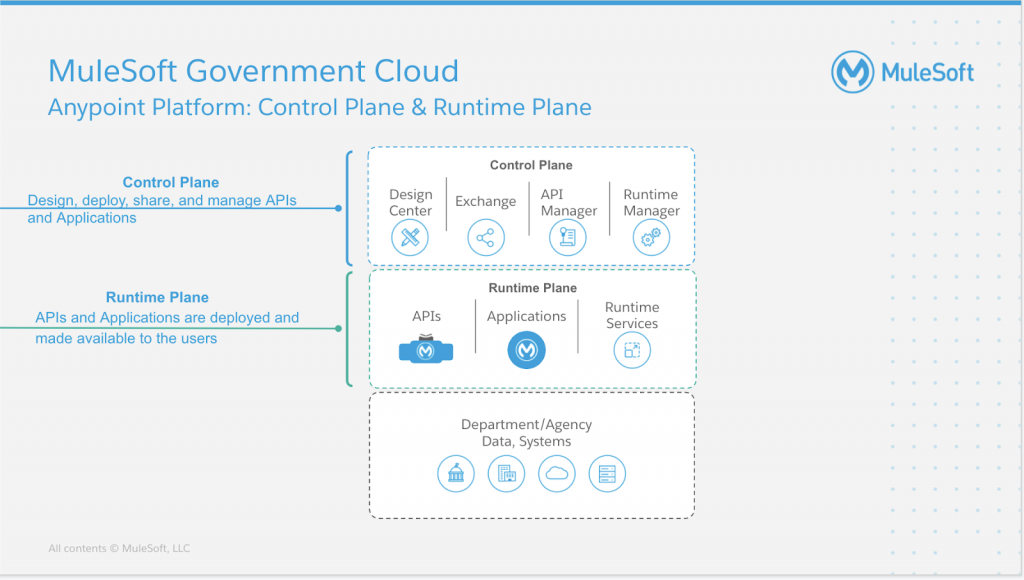The Government’s Cloud First initiative and the Office of Management and Budget (OMB)’s Cloud Smart strategy announcement is to drive cloud adoption in federal agencies. The federal agencies have struggled to get out from under the old, insecure legacy applications they have inherited. The inability to move toward a citizen-friendly experience, meeting the FedRAMP security and compliance standards has been a challenge.
MuleSoft Government Cloud offers a rock-solid, tested cloud platform that gives options to deploy applications in cloud or on-premise data centers based on the security and compliance requirements of federal agencies. MuleSoft Government Cloud is a FedRAMP-Moderate level authorized deployment environment that enables government agencies to use Anypoint Platform in the cloud. Anypoint Platform meets FedRAMP security and compliance standards. With MuleSoft Government Cloud, you can leverage an integration platform as a service to reduce the infrastructure and management costs and increase speed to market. IT teams can focus on designing and building APIs and integrations rather than managing and maintaining infrastructure with Anypoint Platform. You can manage all government integration assets from a single secure, cloud-based management console.
Anypoint Platform components
Anypoint Platform is a complete solution for API-led connectivity that helps companies build application networks with APIs and integrations, both on-prem and in the cloud. Anypoint Platform is a unified platform for API design and management consisting of control plane and Runtime Plane.

#1 Control plane
The control plane is where you design, deploy, share, and manage APIs and applications. The control plane contains product features and components that are part of:
- Anypoint Design Center for designing API specifications.
- Anypoint Management Center for managing users, APIs, and integrations.
- Anypoint Exchange, a marketplace for publishing and sharing API specification, APIs, and integrations.
- Anypoint Runtime Manager for deploying APIs and integrations in the cloud and in data centers.
#2 Runtime plane
The runtime plane component of Anypoint Platform is where the APIs and Mule applications are deployed and made available to the users. The runtime plane includes the Mule runtime server, Anypoint connectors, and supporting services.
Deployment models for MuleSoft Government Cloud
You have two deployment options for Government Cloud. The first option is fully managed where the control and runtime planes are in the cloud. The second option is where the control plane is in the cloud and the runtime plane is hosted in a customer data center. You can also use a combination of both options where the control plane is in the cloud and the runtime planes are hosted in both MuleSoft cloud and hosted in a customer data center.
#1 Fully managed deployment model
The fully managed deployment model has both control plane and runtime plane on the cloud.

The advantages for fully managed deployment model are:
- Most simple deployment model.
- No customer platform infrastructure needed.
- Seamless upgrades.
- FedRAMP Moderate compliant.
- 99.99% uptime.
- Supports high availability.
- Isolated application/runtime pairs.
- Can manage multiple runtime versions.
- Government Cloud connectivity options to data centers include VPN, VPC peering, etc.
The disadvantages for fully managed deployment model are:
- Certain customers may require certifications or reviews before deploying integrations to the cloud.
- Latency to data source should be considered if connecting to data center
#2 Hybrid deployment model
A hybrid deployment model leverages the control plane in the Mulesoft Cloud and the runtime plane in the customer’s data centers.
The hybrid option enables customers to host Mule runtime server and related APIs in an environment that they themselves manage. The Mule runtime server can run on a physical server, a virtual machine, or within a third-party cloud installation like Amazon Web Services, Microsoft Azure, Google GCP, or other cloud infrastructure providers.
When using customer-hosted runtimes, you are also responsible for providing the infrastructure as well as the framework for high availability, failover, clustering, and load balancing.

The advantages for hybrid deployment model are:
- Most flexible deployment model.
- Supports servers and virtual machines (VM) choices for runtimes on cloud and on-premise data centers.
- Low latency to on-premise data sources.
- Secure connection between the control and runtime planes.
- Most efficient model for customers with on-premise only source and target systems.
- Meets certain customers legal, security, and governance requirements (FedRAMP Moderate).
The disadvantages for hybrid deployment model are:
- Requires customers to host their own infrastructure for an on-premise runtime plane.
- Customers must govern their own firewalls and implement non-functional requirements for on-premise runtime planes (e.g. load balancing, high availability, security, patching etc.).
Now that you are aware of the two MuleSoft Government Cloud deployment models, we look forward to government agencies choosing the model which best suits your requirements to manage all government integration assets from a single secure, cloud-based management console.
Learn more about how government agencies can accelerate digital transformation with MuleSoft’s Government Cloud.









